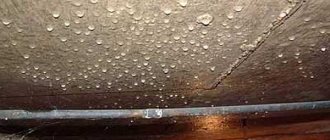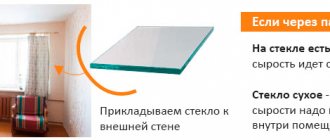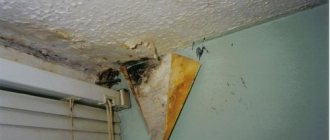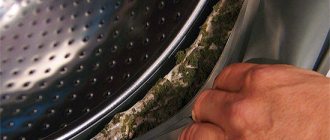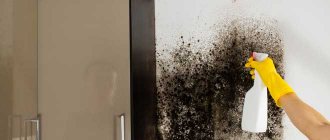When condensation appears in the cellar, how to get rid of it is determined based on the reasons that provoked its formation. Dampness is an unpleasant phenomenon, destroying winter supplies that were sent for storage in the cellar.
When the basement is excessively humid, not only food spoils, but the house also begins to gradually collapse - sag, the foundation becomes weaker. In addition to the risk of losing housing, dampness is also dangerous for the health of residents.
What is condensate
Getting rid of dampness in the basement is possible only after understanding the essence of such a phenomenon as condensation. This phenomenon is directly related to two other concepts - relative and absolute humidity. These two terms are similar in meaning, but differ in the measures they take. And, when the humidity in a room changes in a certain way for some reason, condensation can form. Absolute air humidity is determined in g/m3, and relative humidity is measured in percentage.
The ability of air to hold moisture depends on its temperature. That is, the higher the temperature, the less moisture the air contains, and in the opposite direction. Because of this, a rapid drop in air temperature provokes an increase in its maximum humidity and leads to excess moisture. This excess settles as water droplets on cold surfaces in the basement.
Conditions required for water condensation
For condensation to form in a room there must be a combination of 2 factors - cold surfaces and the regular flow of warm air masses into the basement. In this case, a favorable factor for the formation of condensate is the absence of ventilation holes in the cellar, the presence of which can partially reduce the volume of condensate formed.
For reference! Exhaust ventilation prevents the phenomenon of moisture condensation due to the fact that it removes condensate evaporating from surfaces outside. The ventilation system is an important element of the closed evaporation-condensation-evaporation system.
Reasons for the formation of condensation in the cellar
Moisture can settle on cold surfaces in the cellar due to various factors. But, there are a number of the most common reasons leading to the formation of condensation in basements. Some of the reasons are the result of inappropriate design aspects, and some of them are the influence of natural factors. Most often, the following circumstances lead to the appearance of water droplets and dampness in the cellar:
- Problems with basement ventilation - the problem appears at the design or construction stage of a residential building. Most often, it is expressed by the fact that poorly laid floor slabs or construction waste that has not been removed blocks the ventilation ducts. As a result, condensation forms and conditions favorable for the development of mold arise.
- Capillary flow of water into the cellar through cracks in the masonry or from the soil - if the foundation laying technology is violated, after a certain period of time, moisture will settle on the internal walls of the base of the structure during temperature changes. This negatively affects the strength of the foundation and ultimately can cause a partial collapse of a residential building.
- Increase in groundwater level. In the spring and autumn seasons, due to large amounts of precipitation, the groundwater level increases. This leads to flooding of cellars and basements and, as a result, to dampness. Poor drainage is unable to cope with the problem that has arisen, which creates good conditions for condensation to settle. The result is a vicious circle in which the basement is constantly damp and it is virtually impossible to reduce the level of humidity in it.
It is possible to remove dampness from the cellar after determining the exact cause of its occurrence. Once the root cause is identified, measures must be taken immediately to eliminate it. The sooner the issue with the formation of condensation is resolved, the better - dampness leads to the development of mold, the spores of which enter the air. The presence of mold in a residential building has a negative impact on the health of residents.
Attention! Once in the human respiratory system, these spores lead to various diseases, including dangerous ones - pneumonia, neoplasms (including malignant ones).
Three reasons for dampness in the basement
Naturally, it is simply necessary to deal with all this, and first you need to find out the root of the problem. So, where can water and condensation appear in the basement, let’s consider the main causes of dampness in the basement:
- by capillary route through walls, ceiling, floor;
- directly through cracks;
- condense from the air due to lack (or insufficient) ventilation.
Now that the enemy has been identified, you can begin the fight directly. Yes, before starting work, the water from the basement, of course, needs to be pumped out and the room thoroughly ventilated, and, if possible, dried with a heat gun (fan, hairdryer).
Ways to eliminate the causes of condensation
When the air exchange in the basement is disrupted, the easiest way to correct the situation is to organize additional ventilation of the room. Basement ventilation can be of 2 types - natural and forced. Natural ventilation is carried out through “vents” - holes in the base of the building along the perimeter. For it to work, strict compliance with standards during the construction of a residential building is necessary. According to the rules, the total area of the “vents” must be 1/400 of the area of the building.
Forced ventilation is carried out thanks to specialized equipment that pumps air. Most often, this type of ventilation is used in the case of basements of a large area. Providing forced ventilation is expensive, so this option is not practical in the case of ordinary domestic basements in the private sector.
In addition to arranging ventilation, it is possible to reduce the humidity in the cellar by carrying out 2 procedures - organizing an exhaust hood and performing thermal insulation of utility networks. When sewer and water pipes are laid in the basement, the temperature in them is increased relative to the air. As a result, condensation appears on these communications. To stop heat loss, it is necessary to make a protective shell for the pipes - a “fur coat”. The following types of materials are suitable for thermal insulation of utility networks:
- mineral wool;
- extruded polystyrene foam;
- Styrofoam.
Exhaust hood in the cellar is done by installing a ventilation pipe or duct. They are often built close to load-bearing walls. There are 2 pipes fixed in the cellar - supply and exhaust. According to building codes, in order for the exhaust system to function at full capacity, the pipes are placed at different distances from the basement floor and attached to opposite load-bearing walls.
For reference! It is necessary to locate the exhaust and supply pipes in opposite parts of the room to maintain draft.
When the cause of basement dampness is groundwater
When groundwater gets into the cellar, this is a big problem, which in the long term leads to a partial collapse of the structure. In this case, it is necessary to take a number of auxiliary measures that are aimed at increasing the strength of the foundation and pumping out these waters. It is necessary to dig out the foundation, carry out drainage around the perimeter of the building and make a blind area, strengthen the foundation of the house, organize internal and external waterproofing, and dry the cellar. It is difficult to do this set of work on your own; the best option is to turn to specialists.
Capillary entry of water
When condensation appears on the walls, it is a sign that moisture is penetrating from the environment. To deal with condensation successfully, you need to assess the extent of the problem and choose a method based on its severity. The simplest option is protective waterproofing compounds that close the pores of concrete. They allow you to target holes that are the “entry” for moisture. These products can also be applied to the entire area of the room - when it is difficult to identify problem areas or there are too many of them and they are small.
The second option is the use of waterproofing materials - linocrom, roofing felt, waterproofing. During production, these materials are impregnated with bitumen, which prevents the passage of moisture. The basement must be waterproofed on the inside and, as far as possible, on the outside. For additional protection of walls and floors, polymer resins and bitumen mastic are used. It is possible to distribute such compositions over problem areas of the cellar yourself, but these products are not always able to block the access of moisture to the basement. Therefore, the best solution is to use them together with basement waterproofing.
For reference! There is another way to get rid of capillary penetration of moisture into the cellar and the formation of condensation on the walls - screening. But, this technique is used only in difficult situations - when capillary action is supplemented by groundwater. Protective shields are made of bentonite, clay and geotextiles.
Disinfection and control of fungi and mold
Increased humidity in the cellar leads to the appearance of mold and fungi of various types and colors on the walls, shelves, and ceilings, and all this beauty is accompanied by “aromas.” In this case, take everything that can be taken out of the cellar and lay it out to dry. After drying, whitewash wooden shelves, boxes, boards, and racks with lime with the addition of a solution of copper sulfate. Better twice.
In the cellar, clean off all growths from the walls and ceiling, whitewash with lime and copper sulfate twice (the technology is described at the beginning of the article). Before the main drying, you can carry out special measures that will destroy the spores (or neutralize them for a while).
Lime vapor
Place a barrel in the cellar and fill it with quicklime. Lime is taken at the rate of 3 kg per 1 cubic meter of volume. There should be a maximum of lime in the barrel, a little more than half. Fill everything with water. Don't interfere. Quickly get out and tightly (tightly) close the lid and all ventilation ducts. You can open it in two days, ventilate it well, then you can go down.
Repeat the treatment after 7-10 days. Lime vapors should burn out mold and fungi, destroy insects and their larvae. They also cope very effectively with odors of dampness and mustiness. True, the cellar will smell of lime for several days.
Disinfection of the cellar using lime vapor
Sulfur (smoke) bomb
Use sulfur bomb. They are sold in stores that sell seeds or household supplies. Each one comes with instructions. But, in short, you need to act according to the following scheme:
- take out all metal things; if this is not possible, cover them with a layer of lubricant - grease or something similar.
- You light the fuse of a sulfur bomb, it begins to smolder.
- Get out quickly, close the lid and ventilation ducts hermetically, and leave for 5-6 hours.
If the basement is in the house, it is advisable to leave it during the treatment: a couple of breaths if the airtightness is insufficient and the lungs will need to be put in order for a long time.
Disinfection occurs due to the formation of sulfuric acid. It is obtained by the reaction of sulfuric anhydride and water. Therefore, mold is killed more effectively with a sulfur bomb in damp cellars.
Place the sulfur bomb on the metal, set it on fire, quickly come out and close all the holes.
After 5-6 hours (or after the time indicated on the package), open the ventilation ducts and the lid (in that order). Leave open for at least 12 hours. The remaining gases disappear during this time. You can come in.
From the experience of operating such checkers, we can say that they need to be lit twice as much as normal. Then everything will really be neutralized.
Mold Remover
Sometimes white fluffy growth appears on wood or walls. This is a type of fungus. It can be dealt with using the methods described above, but if only it is present, you can find a product on the construction market for removing solid polyurethane foam (sold in the same place where the foam is sold). Insert the tube into the mounting gun and apply it to areas with fungus. It immediately begins to curl up. And then it doesn’t appear in this place.
You can get rid of this evil spirits using a foam remover.
Floor bedding
If you have an earthen floor, lay a thick plastic film on it (for which it is described above), knock down the wooden grates and throw them on the floor. Scatter pieces of slaked lime under them. And they will collect moisture and create “bad” conditions for fungi.
Organizing proper air inflow and outflow
In the battle with dampness in the basement, well-functioning ventilation plays an important role. Ventilation must be of a supply-and-exhaust nature and, better, when the ventilation system is through - the exits are located on 2 opposite sides of the cellar. Outlet 1 of the pipe should be located 30-40 cm higher relative to the floor level. The end of the other ventilation pipe must be fixed directly under the ceiling. It is possible to enhance the ventilation capacity by installing a fan in one of the pipes, which will allow increasing the air flow if necessary.
However, opening the ventilation in a cellar used for storing food is not recommended during the warm season. You can ventilate the basement with food only when the temperature outside becomes lower than in the room. In another option, warm air coming from the street will lead to the opposite effect - condensation will begin to accumulate in the cellar. Most often, during the spring-summer season and early autumn, the ventilation ducts in the basement are blocked.
When the basement is used as a utility room, it is possible to ventilate it all year round - even when the temperature outside is higher. But in order not to provoke the formation of condensation, it is necessary to use a ventilation unit during ventilation. This will help eliminate the temperature difference in a short time. After the temperature in the basement and outside have become equal, you need to periodically turn on the fan again - in the room the thermometer mark will slowly decrease, since it is located underground.
Natural ventilation
To prevent the accumulation of excess moisture in the basement, you must first arrange natural ventilation. To do this, you need to make supply and exhaust ventilation in the wall. Two pipes with a cross section of 12 mm will be needed. One is placed at the base of the wall - for inflow. The pipe for the outflow of air masses must be located under the ceiling of the cellar. The higher the end of the pipe is from the floor, the stronger the outflow. The pipes are wrapped in a “fur coat” - they are thermally insulated. The pipe openings are covered with mesh to keep insects out. In addition, the outlet ground ends are protected from above by a cone from precipitation.
Attention! The pipe diameter of 12 mm is suitable for small cellars - up to 10 m2; in the case of a more spacious room, a larger cross-section is needed. The material is not important - both metal and plastic are suitable.
When organizing natural ventilation, it is necessary to take into account the correct location of the elements. We must also not forget that the natural type of ventilation can cope with its main function only in the cold season, when outflow and inflow occur due to temperature differences. During warm periods, the basement must be ventilated.
Forced ventilation
Certain valves are installed on the pipes, which are designed to regulate air flows. In summer, the valve is opened to the maximum, and in the winter season the gap is calibrated, depending on the severity of the frost. If the temperatures in the basement and outside are equal, then a fan is installed on the supply pipe. It can be turned on automatically or manually. When the fan starts working automatically, it is more convenient, since there is no need to control and select the moments to turn the hood on and off. If there is a risk of condensation, the automatic system is activated and the hood starts working.
Insulation and waterproofing of external enclosing structures
Before starting to organize waterproofing and insulation, it is necessary to determine the general condition of the residential building. Often the basement is excessively damp due to improper drainage installation. To make sure that the drainage system was installed correctly and that there are no other easily eliminated reasons due to which condensation appears in the basement, you need to perform the following sequence of actions:
- Carry out a careful inspection of each of the slopes on the building.
- They check whether the drainage pipes drain liquid into a special storm drain funnel located underground, or into a gutter.
- Check the drainage system that is located around the building.
- The condition of the blind area is assessed. When there are signs of damage, it is necessary to remove the damaged parts.
For reference! If problems are identified, they must be eliminated as soon as possible. Only after eliminating the shortcomings is it possible to move on to protecting the walls underground.
Outside the walls of the basement, a small hole is dug, the depth of which is 50 cm below the floor level in the cellar, and the width is 0.5 m. The outer part of the walls of the house is dried - naturally or using specialized construction equipment. After drying, the walls are treated with antiseptic mortars. The dug hole is filled with crushed stone. A dense blind area is made from roofing felt, which is fixed to the wall of the building. The roofing material is placed 50 cm above ground level and taken around the corner of the outer wall. A well-made blind area is coated with bitumen mastic.
Exhaust device
To select the required ventilation unit, you need to know the required performance of the ventilation complex and the nominal resistance of the air ducts. In the case of the forced type, 1 fan is enough, which is built into the exhaust pipe. In general, a ventilation unit is not needed in the supply duct - the minimum pressure difference between the point of air mass intake and its supply, which is created by the operation of the exhaust fan, is sufficient.
When choosing between insufficiently and overly powerful veterinary installations, it is necessary to give priority to the more productive one. There are several ways to optimize an overly powerful fan. The first optimization option is to install a throttle valve in front of the ventilation unit, which will slightly reduce the power, but at the same time the load on the fan will increase.
The second way is to turn on the ventilation unit at medium and low speeds. But this is only possible in the case of expensive models; cheap options have only 3 speeds, which are not enough to properly balance performance. The last way is to minimize maximum performance. This can be achieved by controlling the highest fan rotation speed - if provided by the manufacturer.
Attention! Since housing construction standards do not provide for the use of vertical options for natural exhaust as the basis for forced ventilation, it is prohibited to install air ducts on them. But, if it is impossible to separate the air discharge and intake pipes to opposite parts of the basement, you need to separate the exhaust and supply ducts vertically by 3 m or more.
Insulation and vapor barrier of the ceiling
When the floors in a house are made of wood or concrete, there are difficulties in insulating the gap between the basement and the living space. If there is no insulation, then condensation may appear due to heat coming from the house. It is impossible to make a dense screed on the floor, since wooden floors, and sometimes concrete ones, may not withstand the weight of the cement mortar. But when there is a concrete slab between the house and the basement, heavier options are selected. You can insulate the surface between the cellar and the house with the following materials:
- Expanded polystyrene. Mats and slabs for laying heated floors are produced from this material. The best density for wooden floors is 35 kg*m3; for concrete it is possible to choose another one. The main qualities of this option are ease of placement, moisture resistance, vapor tightness and high-quality thermal insulation.
- Mineral wool is also suitable for insulating basement floors, but this option requires additional waterproofing from the side of the house - the material is hygroscopic and loses its thermal insulation properties when wet. It is recommended to provide a vapor barrier on the bottom side when there is high humidity in the cellar.
- Expanded clay is a low-mass bulk material that can be used in floors. According to its properties, it is not flammable, but it absorbs moisture, increasing its own mass, which is why it places an increased load on the floors. It is recommended to lay them in cells under the floor with additional vapor and waterproofing.
- Ecowool is an environmentally friendly material that is used as insulation. Does not burn, does not sag and does not lose properties when wet. The insulation is used in solution and dry form, but the technological process includes the need to use injection equipment, so it will not be possible to lay it yourself.
- Wood sawdust is a natural material with a low price. Among the disadvantages, they emphasize susceptibility to fire, rot, fungus, insects, rodents. Such material can be used exclusively in a mixture with gypsum, lime or clay mortar, which leads to a decrease in insulating qualities and increases its weight.
- Liquid polyurethane foam is an analogue of polyurethane foam, which is intended for insulating surfaces. When applied evenly, it forms a dense insulating coating. The material is applied by spraying onto the surface. Among the properties noted are moisture resistance and lightness. The main disadvantage is susceptibility to fire.
Attention! It will not be possible to install a warm floor over a basement with wooden floors, due to the fact that the design involves laying cement mortar. This type of screed is not applicable to wooden floors, since the mass of this insulation option is significant.
Insulation of basement walls of an operating building
When the floor insulation was carried out with high-quality materials, but condensation in the basement continued to accumulate, then there is a need to perform such a procedure in relation to the walls and floor. Vertical surfaces are insulated with polystyrene foam boards and polyurethane foam - these materials are more resistant to constant exposure to moisture. But even with such stability, waterproofing walls is of great importance.
Preventing dampness
As usual, this “disease” is easier (and cheaper) to prevent than to treat. Still being decided at the design stage:
- The material of the walls and floors must have a low degree of hygroscopicity, and poorly conduct water in both liquid and gaseous states. The best from this point of view is high-quality concrete - from M400 and above. But he builds a lot. You can add special substances to the regular M200 or M250 that increase water-repellent properties. (read about concrete brands and their composition here)
Eliminating condensation in the cellar is more difficult than preventing its occurrence - If groundwater is close or its level rises significantly in spring/autumn, external waterproofing is necessary. Liquid compounds are applied to the outside walls (better) or rolled ones are fused (cheaper, but less effective).
- If the cellar is being built on a slope, a drainage pipe must be laid in the ground above it, which will drain the precipitation flowing down the slope.
- A blind area is made around the cellar (or the building under which it is located), which removes precipitation flowing from the roof.
- Inside the cellar, in opposite corners, there must be two ventilation pipes with a diameter of at least 125 mm. One of them ends at floor level - 10 cm higher. Air from the street or room enters through it (supply pipe). The second ends almost at the ceiling - 10 cm below its level. This is a hood. Ventilation pipes on the street should be covered with umbrellas to prevent leaves and precipitation from getting into them. The exhaust pipe (the one that ends near the ceiling) should be higher and it is better to install a deflector on it to activate the draft. It can be painted black: due to heating from the sun, the draft should be better. Another subtlety: for good traction, ventilation ducts with natural air movement must be straight. If it is necessary to make a bend to the side, its angle of inclination must be at least 60° relative to the horizon, and the length of the inclined section should not exceed 100 cm.
Drying a cellar without ventilation is a difficult task. The figure shows a diagram of the organization of ventilation ducts to maintain normal humidity in the cellar - Between the room located above and the basement there should be a vapor barrier that prevents moisture from penetrating both from the basement and into the basement.
Inspecting the floor
Very often the floor in the cellar is made of earth. This is often the source of excess moisture. Through it, the moisture contained in the soil gets inside. To reduce humidity in the cellar, you need to level the earthen floor, compact it and cover it with thick plastic film. You can use roofing felt, but it breaks more often. Although it seems more durable, it breaks due to less elasticity.
There is no need to pour sand or soil on top of the film. Sometimes there is a large amount of water in the basement (accidental flooding). Then you simply remove the film, the water goes partly into the ground, partly evaporates through the ventilation. After the dampness has gone, you can re-cover the floor. If there is earth or sand on top, you will need to poke around in this slurry, extracting the film.
If the floor in the cellar is earthen, most of the moisture enters through it
If after laying the film the humidity level in the cellar has decreased, then you have found the reason. You can leave everything as is, just change the “flooring” periodically, or you can make a concrete floor with full waterproofing. The choice is yours. To prevent the film from tearing when people walk on it, knock down the wooden panels and throw them on the floor.
Improving waterproofing
The second reason why humidity increases in the basement is an insufficient degree of vapor barrier or waterproofing of the walls. This usually occurs if the cellar is lined with brick, especially silicate brick. The material is very hygroscopic and allows water vapor to pass through well. They settle in drops on the ceiling and all objects.
The problem can be solved if you make good external waterproofing: dig out the walls and apply bitumen mastic in two layers. Previously, they were coated with resin, but mastic is more effective and easier to handle.
Brick walls require additional waterproofing
But excavation work is not always a joy, and it’s not always possible to dig out the walls. In this case, you can make internal waterproofing of the cellar walls. For this purpose, there are cement-based impregnations: “Pnetron”, “Kalmatron”, “Hydrotex”, etc. They penetrate to a depth of up to half a meter into the thickness of the material (concrete, brick, etc.) and block the capillaries through which water seeps. Water permeability decreases significantly. Their only drawback is the price. But they are really effective.
All these measures will prevent the appearance of high humidity in the basement. But what to do if there is already moisture, how to dry the cellar? Next, we’ll look at ways to reduce humidity.
Read how to organize drip irrigation for your garden yourself here.
How to dry a basement or cellar
When you need to drain the cellar in the warm season, there is a difficulty in the issue of natural circulation - cold air will remain in the cellar in warm or hot weather. For drying, heating is carried out or artificial draft is created. The greater the degree of heating of the basement, the faster the moisture will leave. To ensure heating, they often resort to the following technique:
- Select a bucket or other container of similar volume and make holes in it. This container should be securely tied to a non-flammable rope.
- Charcoal, suitable for barbecue or lit at home, is placed inside the prepared vessel and lit.
- When the coals are already hot and stably maintain temperature and smoldering, the container should be lowered into the basement and left hanging above the floor.
- The cellar lid is closed, but to ensure the oxygen necessary for combustion is torn off once every 20-30 minutes.
Attention! The coals go out if there is not enough air - you need to take out a bucket and re-ignite the flame to dry. To ensure additional air flow, it is also recommended to connect a blowing vacuum cleaner or blowing fan to the ventilation inlet duct.
When the coals have completely burned out, the vessel is removed from the basement and the hatch is closed for 2-3 days. This will ensure that carbon monoxide remains in the underground to kill mold and bacteria. This approach alone is enough to completely dry out the basement in dry weather. Instead of charcoal, it is recommended to use coke or coal, but such options smoke soot and require more air flow to ensure long-term combustion. The duration of combustion of coal and coke is longer, as is the amount of heat generated, so this option will allow you to more effectively drain a damp basement.
Internal basement waterproofing
To get rid of dampness in the basement, you need to:
- First, dry the room thoroughly.
- Get rid of crumbling coatings.
- Clean out the cracks.
- Seal them with cement mortar.
- Impregnate the walls with an antifungal agent;
- Coat everything with a waterproofing solution (the simplest one is bitumen mastic).
Pressure leaks, as well as their former places, must be very carefully sealed, for example, with alabaster.
To enhance the effect, you can plaster the walls completely or only partially 0.5–1 meter from the floor. But this stage is not mandatory.
You can also make new walls from moisture-resistant material; in large basements, new brickwork is often built. There should be a distance of at least 3 cm between the old and new walls. It is important to drill holes between the old and new walls so that air from the basement escapes into the external ventilation holes, and also to prevent moisture from accumulating between the walls.
Dampness in the basement can also be caused by an old floor, even if it is a concrete screed. To correct the situation, it is necessary to remove the decorative flooring and seal all cracks in the concrete, if any. Then wait until everything dries, cover it with sand or expanded clay - the layer should be about 5 cm, and then lay roofing felt or other waterproof durable material. After treatment with bitumen mastic, you can make a new screed or lay logs, and a plank floor on them.
How to properly waterproof a foundation.
You need to make brickwork, the following article will help you with this.
About preparing plaster mortar in our instructions.
What is a possible substitute for coal?
Coal - charcoal, coke or stone - are not the only combustible materials for heating the basement. It can also be used for drying cellars using other types of fuel, including electrical appliances. The technique for using them may differ slightly from the tactics used with coal. As an alternative to combating condensation, the following types of heaters can be used:
- Propane torch. The ignited device is also lowered underground on a cable. But, you need to more closely monitor the behavior of the flame and ensure safety from fires.
- Kerosene stove. Kerosene blowtorches are also used for heating. But there is an even higher risk of fire if there are flammable materials in the ceiling or shelving elements.
- Heat gun. Such devices are used for heating hangar rooms and working with thermoplastic materials (stretch ceilings, etc.). The power of the device must be at least 3-5 kW.
- Potbelly stove. A portable metal stove can also help remove moisture from the cellar. The potbelly stove should be placed in the basement with a chimney connected through a hatch and the room should be heated.
This approach will not only eliminate condensation in the underground, but will also clear the floors of insects, rodents and fungus. It is not recommended to use burners and potbelly stoves alone - you need an assistant who will stay outside and monitor safety. This is associated with a high risk of gas poisoning or loss of the ability to leave the cellar on your own. The heat gun alone can be lowered on a cable, and the potbelly stove needs to be melted below.
Attention! You cannot go into the basement during the procedure, as temperatures can reach 70ºC, and all oxygen will be replaced by smoke and carbon monoxide.
Valuable advice
If you have a fairly old building , and cracks still appear in the basement from time to time (in the corners, between the bricks), then as a temporary measure you can plug them with rags coated with bitumen mastic and plaster the top.
In the basement, from where you need to pump out water, it is worth organizing a pit - a waterproof “glass” made of metal, concrete with waterproofing or other similar material.
We will already pump water out of it with a pump. The floor in the basement should be inclined, even if only slightly, directed towards one corner. There is a pit in this corner. Then all the water will collect where we can easily deal with it.
Alternative drying options
Depending on the type of room under which the basement is located, various difficulties arise with drying. In the case of a garage, any options are suitable, including not the cleanest ones, such as drying using hot coals. But, if the basement is located under the living rooms, then care and attention must be exercised - the foundation cannot be broken, there are obstacles to laying pipes in the form of ceilings and walls. It is best to install a ventilation pipe through a hatch or, as an option, consider ways to collect moisture directly in the underground. To do this, hygroscopic materials are placed below:
- Dry sawdust or shavings. This method cannot completely eliminate excess moisture. But, regularly replacing the material with fresh sawdust or shavings eliminates condensation from the room, which is also important for preserving the basement.
- Cardboard boxes can act as a substitute for sawdust and shavings, as they absorb water well. If you put in a sufficient amount overnight, then in the morning the spreading residues are removed, along with the reduction of condensation. With regular replacement, just like with sawdust, condensation will disappear.
- Slaked lime is used for whitewashing premises, but this material also absorbs moisture well. To reduce humidity in the underground, lime is poured along the walls and on the shelves. The moisture in the room will be absorbed, and the lime fumes will destroy the fungus.
- Calcium chloride, like lime, is dangerous due to its own fumes, but it collects water well - 1 kg absorbs up to 1.5 liters of moisture. The substance is lowered into the basement and left for 24 hours. If the calcium is dried by calcination, the material is again suitable for use.
When the listed options are not available or do not help, you can turn your attention to modern technology - household air dehumidifiers are on sale. Their main purpose is to dry rooms with swimming pools, but for a basement such a large capacity is not needed - mid-level models cost about 20-30 thousand Russian rubles. rub. and are connected to a 220 V network.
Attention! After switching on, the device collects moisture from the air into a suitable container - it must be cleaned regularly.
Preparatory work
All supplies are removed from the basement, as well as all wooden structures, and thoroughly cleaned. On the street they inspect the wood - shelves/drawers/boxes. If they are not damaged, and there is no fungus or mold, they are simply laid out in the sun to dry. If there are traces of damage, the wood is impregnated with a solution of copper sulfate (concentration 5-10%, no more).
Whitewashing with lime gives good results - it will also “collect” moisture from the air. Therefore, before draining the basement, it makes sense to whitewash everything. They just do it differently from the outside. It is necessary to apply a thick layer of lime to the walls. To do this, make a bucket of thick whitewash and add a little diluted copper sulfate. It is an excellent disinfectant, but the concentration should not be higher than 5%, maximum 10. The resulting thick liquid is poured in half into two containers.
This is what a whitewash paint brush looks like
The first half is lowered into the basement, dressed in old clothes, glasses, and covered hands. Take a whitewash paint brush (it looks more like a small broom) and coat the corners well with it. Then you stir the slurry with a brush and spray it on the walls and ceiling. Just dip it in thick whitewash and spray it on the walls. They are covered with drops and tubercles of lime.
After everything is covered with lime, wait a day for it to dry. Repeat everything with the second bucket. As a result, the walls and ceiling are porous and uneven. But condensation rarely hangs on them: lime retains moisture well inside. After the lime has dried, you can begin drying the cellar.
Building a greenhouse with your own hands is described here.
If there is mold in a wooden cellar
If the basement smells of dampness and mold has appeared on the shelves, shelves and drawers, emergency measures should be taken.
How to remove dampness and fungus from wood:
- We take out all the structures.
- We treat the walls and ceiling with a solution of soap and soda with water.
- Then we dry the room. What to do next? After which it is necessary to carry out disinfection. Lime and clay in equal quantities are dissolved in 10 liters of water, 100 g of copper sulfate is added and the shelves and drawers are treated. The floor can also be treated this way, even if it is earthen.
Then the cellar is dried. To speed up the process, install a heat gun or electric heaters in the room.
If the area is very humid, drying may take a long time. Therefore, the cellar should be ventilated daily.
You can treat wooden surfaces in the following ways:
- Take one of these products: sodium fluoride, zinc chlorine, ammonium or sodium fluoride in a volume of 30 g. The substance is diluted in hot water and all wooden structures are treated.
- How to make the paste: you will need 135 g of clay, a glass of water and 150 g of sodium fluoride. First, the chemical is added to the water, and then the clay is poured. You should get a homogeneous creamy mixture. All wooden racks, walls and drawers are treated with this composition.
Such methods will protect wooden structures from moisture and mold.
Blitz for the fastest
Briefly all methods of dealing with dampness in the basement:
- We carry out external waterproofing work (storm drainage, coating of external walls with bitumen, arrangement of blind areas)
- We remove mold.
- We carry out repair work to eliminate cracks.
- We are making new waterproofing.
- Setting up ventilation.
Having done all of the above, you can be sure that your home will be insured against the occurrence of such an extremely undesirable phenomenon as dampness and mold, which can affect not only the basement, but also living quarters.
Questions and answers
Let's answer a few typical questions cellar owners ask.
What humidity should be in the cellar?
If you're storing canned food in it, the answer is simple: less is more. But when storing vegetables, the optimal range is 80-95%: they should not only not become moldy, but also dry out.
What temperature should the cellar be in summer?
No higher than 12 degrees. If on hot days the thermometer creeps up from this mark, it makes sense to take care of the thermal insulation of the upper part of the room.
What should be the temperature in the cellar in winter?
Steadily above zero. The reason is obvious: jars of home canning can burst with ice, and crystallization of water in fresh vegetables, to put it mildly, will not improve their taste.
Optimal storage conditions for some fruits and vegetables.
How deep should the cellar be?
Ideally, its ceiling should be below the freezing level. With proper thermal insulation of the entrance, the temperature in it will always be equal to the ground temperature, and the problem of condensation simply will not arise.
Drying the cellar with a candle
If you don't want to bother with a Dutch oven, there is an easier way to keep your cellar dry and free of moisture. For this you will need a very ordinary candle.
The candle must be placed under the exhaust pipe.
A lit candle placed under the exhaust duct will increase air draft and also help get rid of dampness. Drying the cellar with a candle will take much longer than with a brazier, but if you have nowhere to rush, then you can use this method without any problems.
Ventilation
Sometimes, when determining why it is damp in the basement, you may not understand for a long time, as a result of which moisture penetrates into the room. Let's figure out how to get rid of dampness in the basement due to poor ventilation. After all, this can also lead to bad consequences.
Internal ventilation required:
- It should have a supply and exhaust system. The simplest scheme: two pipes, one of which comes almost from the basement floor, going outside under the ceiling, and the second is located directly under the ceiling and also leads outside.
- All of the outer parts of these pipes must be reliably protected from the possibility of rain and melt water.
Read on: Basement ventilation: consider, choose and do


